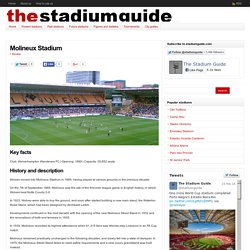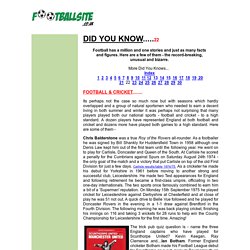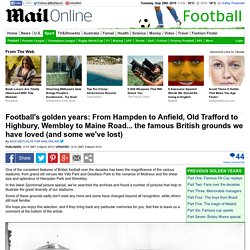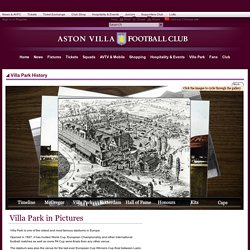

Premiership football grounds from the air. HAMPDEN PARK GLASGOW. HAMPDEN PARK GLASGOW. Doing The 92 ~ Home. Exciting new code!

We know that not everyone reads the front page so here's a bonus for those of you that do. We've introduced some new code to make game entry much easier but because it's new there's bound to be the odd bug or two. Therefore please use it with caution initially. To activate it, click on the My Profile' button and set 'Fast Game Entry' to Yes.
Go to Stats / Seasons / Teams and you'll see that every game now has a tick box next to it. Once you've added some games, come back to this page and click the new 'All My Games' button. Please remember this is new code - let us know about any quirks and we'll get them sorted out. Molineux Stadium - The Stadium Guide. Key facts Club: Wolverhampton Wanderers FC | Opening: 1889 | Capacity: 30,852 seats History and description Wolves moved into Molineux Stadium in 1889, having played at various grounds in the previous decade.

On the 7th of September 1889, Molineux was the site of the first ever league game in English history, in which Wolves beat Notts County 2-0. In 1923, Wolves were able to buy the ground, and soon after started building a new main stand, the Waterloo Road Stand, which had been designed by Archibald Leitch. Lost football grounds... Turf Moor in the old days could be pretty inhospitable.

Usually got given a small corner of a very large terrace along the pitch side.. Been to every dodgy place over the years, Upton Park, Elland Road, NInian Park, the old Den etc and have never been anywhere as unwelcoming as Turf Moor.Remember my first visit in 1992. Mate and I went up on the train, idea was to get up early find a few nice friendly Lancashire hostelries and have a few.Should have figured something wasn`t quite right when there were loads of mounted police at the station to welcome us. We were then told we were being escorted to the ground for our own safety. It was about 12.30 so the 25 or so Fulham fans were not impressed.Off we went then turned a corner and loads of Burnley just poured out of a pub and basically charged straight into us, the police literally battered them back into the pub, pretty shocking to be honest because it was very sudden.
116. Photo of Odsal Stadium 1954. Footballsite - some of the record-breaking, unusual and bizarre football stories. Its perhaps not the case so much now but with seasons which hardly overlapped and a group of natural sportsmen who needed to earn a decent living in both summer and winter it was perhaps not surprising that many players played both our national sports - football and cricket - to a high standard.

A dozen players have represented England at both football and cricket and dozens more have played both games to a high standard. Here are some of them - Chris Balderstone was a true Roy of the Rovers all-rounder. As a footballer he was signed by Bill Shankly for Huddersfield Town in 1958 although one Denis Law kept him out of the first team until the following year. He went on to play for Carlisle, Doncaster and Queen of the South. The trick pub quiz question is - name the three England captains who have played for Scunthorpe United? Brothers Denis and Leslie Compton had sport, and more particularly Arsenal and Middlesex, in their genes. Lost Ground: Estadio Lluís Sitjar. Estadio Lluís Sitjar was a beautiful stadium in Palma de Mallorca, Spain.

What happened to England's lost football grounds? West Ham United are due to move to the Olympic Stadium in Stratford from Upton Park in 2016 while Tottenham Hotspur, who have plans for a new stadium next to their current White Hart Lane ground, will have to find a temporary home venue for the 2017-18 season.

They are just the latest clubs to leave their long-established homes - a trend which began in the 1990s and which shows no signs of abating. So what became of England's lost football grounds? Arsenal: Highbury. Closed in 2006 There are hundreds of flats around the old Highbury pitch and John Jeans lives in one with a view of the famous turf from the old North Bank.
However, while this is a dream for many Arsenal fans, Dr Jeans has slightly mixed feelings about it. Lost Football grounds Street View. The Itinerant Football Watcher. The sheer amount of non-league grounds that have disappeared in the last three decades is staggering.

Here I pause to remember just a handful of them. GROUND: Dark Lane, Staghills Road, Newchurch, Waterfoot, Lancashire RECORD ATTENDANCE: 3,450 v Shrewsbury Town (FA Cup) 22/11/1975. Abandoned Football Grounds. 25 Incredible Football Stadiums You Didn't Even Know Existed. Scotland’s lost football grounds remembered. They are stadiums whose names are engrained into Scottish football folklore.

Here we look at some of the country’s famous football grounds that are no longer with us. Douglas Park - Hamilton Academicals FC Home to the Accies from 1888 to 1994, Douglas Park’s largest attendance came in 1937 when 28,690 spectators watched Hamilton take on Hearts. Once closed, the ground’s turnstyles were sold to Falkirk while part of the main stand was bought by junior side Auchinleck Talbot. Football's golden years: From Hampden to The Dell, .... By Nick Metcalfe for MailOnline Published: 11:07 GMT, 6 March 2013 | Updated: 14:31 GMT, 6 March 2013 One of the consistent features of British football over the decades has been the magnificence of the various stadiums, from grand old venues like Villa Park and Goodison Park to the romance of Molineux and the sheer size and splendour of Hampden Park and Wembley.

In this latest Sportsmail picture special, we've searched the archives and found a number of pictures that help to illustrate the great diversity of our stadiums. Some of these grounds sadly don't exist any more and some have changed beyond all recognition, while others still look familiar. We hope you enjoy this selection, and if they bring back any particular memories for you, feel free to leave us a comment at the bottom of the article.
Aston Villa. Villa Park is one of the oldest and most famous stadiums in Europe.

Opened in 1897, it has hosted World Cup, European Championship and other international football matches as well as more FA Cup semi-finals than any other venue. The stadium was also the venue for the last ever European Cup Winners Cup final between Lazio and Real Mallorca in 1999. World Cup Venue This famous venue is also one of a very select few that has hosted international matches over three different centuries, the first senior international taking place in 1899. Chelsea v Liverpool FC: Vintage photographs of Kenny Dalglish's men sealing the first leg of the 1986 Double. St James' Park story: How the home of Newcastle United became one of the most iconic in the world. FANS.